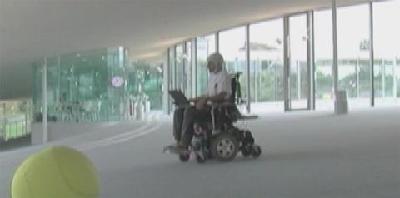
This is the VOA Special English Technology Report.
Since the 1970s, scientists have been searching for ways to link the brain with computers. Brain-computer interface, or BCI technology could help people with disabilities send commands to machines.
Recently, scientists demonstrated a small robotic vehicle directed by a person's thoughts. The demonstration took place at the Swiss embassy in Washington. Jose Millan and Michele Tavella developed the system. Mr. Tavella can even talk as he watches the vehicle and guides it with his thoughts.
MICHELE TAVELLA: "That's very, very easy. That's the simplest part we could say because moving one hand or the other is a very, very common task. There is no workload. It's very, very simple."
Mr. Tavella is a researcher at the Federal Polytechnic School in Lausanne, Switzerland. In the laboratory, he can operate a wheelchair just by thinking about moving his left or right hand.
Professor Millan is the team leader. He says systems like those being developed in Lausanne and other places may be available in less than ten years.
JOSE MILLAN: "The brain-machine interface is a system that allows disabled people, people suffering from physical disabilities to communicate with external world and also to control devices."
Our brain has billions of nerve cells. These send signals through the spinal cord to the muscles to give us the ability to move. But spinal cord injuries or other conditions can prevent these weak electrical signals from reaching the muscles.
The researchers designed a special cap for the user. This head cover captures the signals from the scalp and redirects them to a computer. The computer interprets the signals and commands the motorized wheelchair. The wheelchair also has two cameras that identify objects in its path. They help the computer react to commands from the brain.
Professor Millan says scientists keep improving the computer software that identifies brain signals and turns them into simple commands.
JOSE MILLAN: "The practical possibilities that brain-machine interfaces offer to disabled people can be grouped in two categories: Communication, and controlling physical devices and virtual devices. One example is this wheelchair."
He says his team has set two goals.
JOSE MILLAN: "What we want is to bring this technology out of the lab and this has two components. First is testing with real patients, so as to demonstrate that this is a feasible technology they can benefit from. And the second aspect of that is to guarantee that they can use the technology over long periods of time."
And that's the VOA Special English Technology Report. Transcripts, MP3s and podcasts of our reports are at voaspecialenglish.com. You can also find us on Facebook and YouTube at VOA Learning English. I'm Robert Cohen.
spinal cord: the mass of nerves inside the spine that connects all parts of the body to the brain 脊髓
Looking to robots and other technology to improve health care
美研發(fā)“舌頭駕駛系統(tǒng)” 幫助殘疾人控制輪椅
Technology brings jobs to the disabled
How technology can help disabled people
(來源:VOA 編輯:崔旭燕)
